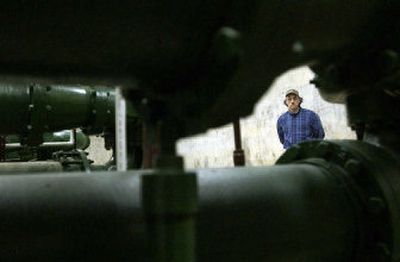River pollution an obstacle to county treatment plant

Spokane county leaders are concerned a new state proposal on reducing phosphorus pollution in the Spokane River could delay or even sink plans for a new wastewater treatment plant.
Failing to increase sewer capacity in the next four or five years could force a halt in new construction until a solution is found.
County and state Department of Ecology leaders are meeting today to hash out the county’s concerns, and Commissioner Todd Mielke said he remains optimistic that the state and county will come to an agreement.
Still, he said if the plan doesn’t change, the county likely will sue.
Environmentalists say the county’s concerns about a new plant are overblown and note that some – albeit smaller – plants are meeting the phosphorus pollution standards the state Department of Ecology is considering for the Spokane River.
Here’s a look at some of the issues surrounding the new plant.
Q:What’s the county’s time frame?
A:The county handles sewage for about 30,000 customers from Spokane Valley and unincorporated areas north and east of Spokane.
After running through county sewer lines, the waste – about 7.5 million gallons a day – is treated at the city of Spokane’s sewage plant. The county’s contract with the city allows it to treat up to 10 million gallons each day.
With growth and plans to convert 10,000 homes from septic tanks to its sewer system, the county’s treatment capacity is expected to be reached around 2011. Mielke said it can take three to four years to build a sewage plant. To finish construction before capacity runs out, the county would like to break ground as soon as possible.
Q:What could be the holdup?
A:Plants already in operation have several years to meet new phosphorus limits.
But the Clean Water Act requires that a new plant meet the standard immediately, said Dave Peeler, Department of Ecology’s water quality program manager.
The county maintains that the standards are so strict that it’s unclear if technology exists for large plants to meet it affordably, especially if they have to meet restrictions on the first day of operation.
“If we build a new regional treatment plant that was state of the art, is it a new treatment plant or is it a relocation of a flow that otherwise would go though the city of Spokane treatment plant?” asked Bruce Rawls, county utilities director.
Q:Why should we care about phosphorus in the river?
A:Algae feed on phosphorus. When the algae die, they fall to the bottom, and bacteria break them down.
In the process, oxygen is depleted from the water, making life harder to sustain for fish and other aquatic creatures. Oxygen problems aren’t so bad in the Spokane River, but as the body turns into Lake Spokane, oxygen depletion has become a serious problem.
Q:What are the goals for phosphorus?
A:The state has proposed that phosphorus be discharged at a level of 10 micrograms per liter.
Spokane’s wastewater plant currently removes about 90 percent of phosphorus during summer months, which leaves 400 to 500 micrograms of phosphorus per liter in its discharge. One pound equals about 450 million micrograms.
The state proposal on phosphorus says if technology isn’t good enough to meet 10 micrograms, dischargers can take other actions to reduce phosphorus in the river.
For instance, they can take treated sewage and use it to irrigate golf courses or parks, ideas Rawls says the county is considering for the new plant.
Q:Can any plant meet the 10 microgram standard?
A:Yes, but there’s a cost. How much of a cost is up for debate.
Rawls says the only proven way to consistently meet the standard is to use a process called reverse osmosis.
He estimates that could triple the cost of building a new plant to $300 million. Others say the standard could be achieved with much cheaper technology.
A 30-year-old plant in Breckenridge, Colo., that discharges about 1.5 million gallons a day hits the low standard for phosphorus and has done it without huge investments in technology, said Andy Carlsberg, district manager of the Breckenridge Sanitation District.
“I think anybody can do it if they look at their operating procedures,” Carlsberg said.
The 10 microgram number has even been reached during small test runs at the Spokane’s treatment plant.
Four companies recently brought their technology to the plant and tested it at a volume of 43,000 gallons a day, said Mike Cannon, Spokane’s wastewater lab supervisor. Each test showed significant reductions in phosphorus compared with the plant’s current output, and one test came up with a result slightly under 10 micrograms, Cannon said.
Cannon cautioned that the tests were highly controlled and were on a tiny scale compared with the plant’s normal daily output of 38 million gallons a day, which includes city waste.
“It shows promise, but it’s going to be expensive,” Cannon said.
Jim Correll, who has managed improvements at Spokane’s wastewater plant, said numerous factors complicate hitting the goal consistently, including the amount of phosphorus coming into the system and the huge flux in flow.
“The real issue isn’t what the lowest number you can get down to is, but what’s the lowest number you can get down to and stay at,” Correll said.
Q:What’s next in the process?
A:The Ecology Department and Environmental Protection Agency have the final say on the standards for the river but could be sued by environmental organizations if they perceive standards as too easy on pollution or by wastewater dischargers if they consider the decision too strict and costly to ratepayers.
The department plans to present a revised edition of its proposal later this month.